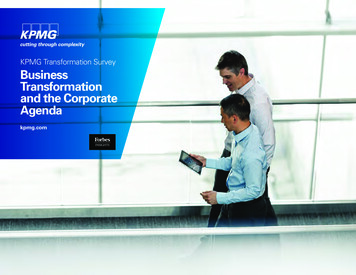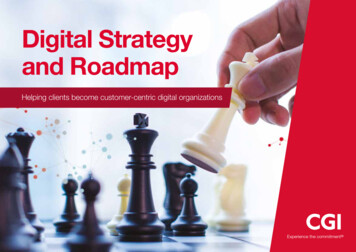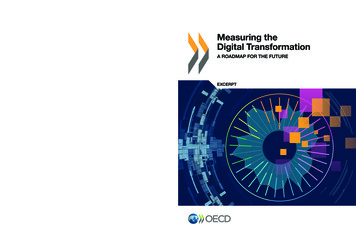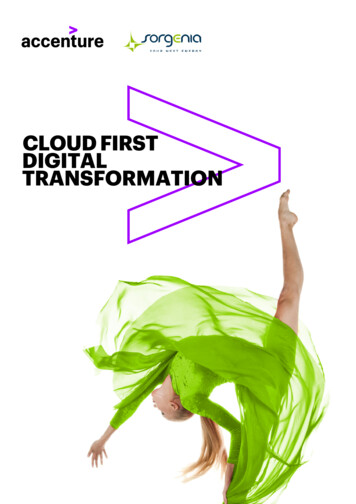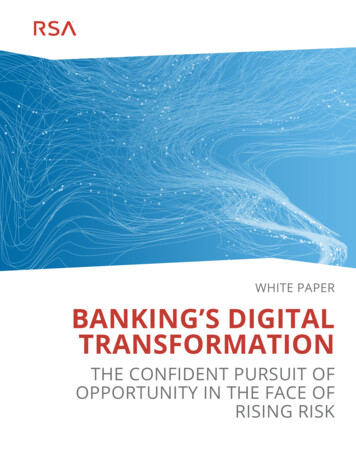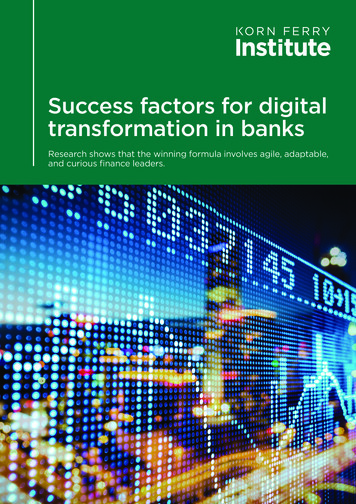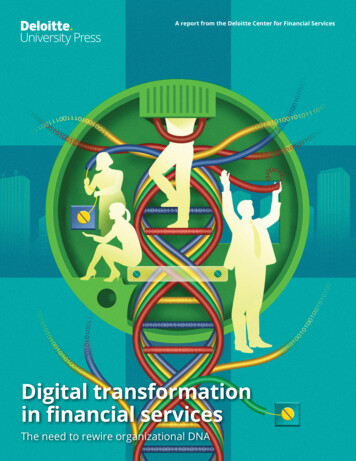
Transcription
MITSloanMANAGEMENTDIGITAL TRANSFORMATION: A ROADMAPFOR BILLION-DOLLAR ORGANIZATIONSFINDINGS FROM PHASE 1 OF THE DIGITAL TRANSFORMATIONSTUDY CONDUCTED BY THE MIT CENTER FOR DIGITALBUSINESS AND CAPGEMINI CONSULTING
Contents2 2011 MIT Center for Digital Business and Capgemini Consulting
1 The Study062 Common pressures; different results083 The shape of digital transformation164 Digital technology usage285 Challenges on the road to transformation346 How can you make your digital journey successful?467 What is digital transformation maturity?588 Conclusion65 Common pressures to begin digital transformation Different digital transformation speeds and different resultsCase Study: Finding new opportunities for digital transformationacross a hospitality companyCase Study: Digital transformation in India Transforming customer experience Transforming operational processes Transforming business models Digital capabilitiesCase Study: Digital transformation in an international banking groupCase Study: Moving from separate to integrated digital initiatives inan apparel manufacturer Initiation challenges Execution challenges Governance challengesCase Study: Evolving as a value chain orchestrator in mortgagesCase Study: Digital transformation in an international airport Envision the digital future for your firm Invest in digital initiatives and skills Lead the change from the topCase Study: Driving digital transformation across a global media company The What and the How Digital Maturity Matrix How to assess your digital maturityCase Study: Capitalizing on digital opportunities for a business directory 2011 MIT Center for Digital Business and Capgemini Consulting3
EXECUTIVESUMMARY4 2011 MIT Center for Digital Business and Capgemini Consulting
Digital transformation (DT) – the use of technology to radicallyimprove performance or reach of enterprises – is becominga hot topic for companies across the globe. Executives inall industries are using digital advances such as analytics,mobility, social media and smart embedded devices – andimproving their use of traditional technologies such as ERP– to change customer relationships, internal processes, andvalue propositions. Other executives, seeing how fast digitaltechnology disrupted media industries in the past decade,know they need to pay attention to changes in their industriesnow.How can senior executives successfully lead digital transformation?While many experts urge companies to get started on the digitaltransformation journey, few tell how to do it. In this report weshare the findings from a global study of how 157 executives in50 large traditional companies are managing – and benefitingfrom – digital transformation. We will describe the elements ofsuccessful digital transformation and show how to assess yourfirm’s digital maturity.Our research shows that, although large traditional firmsare truly different from digital entrants, many are startingto transform their businesses successfully through digitaltechnology. Specifically, Companies face common pressures from customers,employees and competitors to begin or speed up theirdigital transformation. However they are transforming atdifferent paces with different results. Successful digital transformation comes not fromimplementing new technologies but from transformingyour organization to take advantage of the possibilitiesthat new technologies provide. Major digitaltransformation initiatives are centered on re-envisioningcustomer experience, operational processes andbusiness models. Companies are changing howfunctions work, redefining how functions interact, andeven evolving the boundaries of the firm. Successful DT does not happen bottom up. It must bedriven from the top. Focus on the “how” more than the “what.” The mostsuccessful transformations we have seen focus as much(or more) on how to drive change as on the detailedcontent of the change. A compelling transformativevision, with related engagement, governance and KPIswill allow people throughout the enterprise to identifynew “whats” to meet or extend the vision. Successful DT comes not from creating a neworganization, but from reshaping the organization to takeadvantage of valuable existing strategic assets in newways. Companies can do much more to gain value frominvestments they have already made, even as theyenvision radically new ways of working.Despite the hype around innovative digital technologies, mostcompanies still have a long way to go in their digital transformationjourneys. Leadership is essential. Whether using new ortraditional technologies, the key to digital transformationis re-envisioning and driving change in how the companyoperates. That’s a management and people challenge, not justa technology one. 2011 MIT Center for Digital Business and Capgemini Consulting5
1THE STUDY6 2011 MIT Center for Digital Business and Capgemini Consulting
– and benefiting from – DigitalTransformation. We are working tounderstand how digital technology ischanging the business of large leadingfirms.Many popular stories of digitaltransformation involve digital startups or high-tech firms such asAmazon, Apple, or Google. Executivesin traditional companies often findthese examples hollow. Big traditionalcompanies, with decades of historyand legacy, are simply different fromthese newer digital entrants. Otherstories focus on exciting initiativesby traditional companies, but areanecdotal and do not show how thosecompanies implemented the change.These examples may be good triggersfor other companies to take action, butthey give no advice on how or whetherto do so.Phase 1 of this multi-year study is anexploratory investigation involving157 executive-level interviews in50 companies in 15 countries (seeFigure 1). These companies are large,with typically 1 billion or more inannual sales. We conducted in-depthinterviews to qualitatively explore thenature of the digital transformationphenomenon with real executives inreal companies. To provide balancedperspectives, approximately half ofthe interviewees are business leaderssuch as CEOs, line of businessmanagers, marketing heads, orCOOs, while the other half are IT andtechnology leaders.With that in mind, MIT Center forDigital Business and CapgeminiConsulting set out investigate the waysin which large traditional companiesaround the world are managingFigure 1: Interviews cover a broad range of countries and industriesTransportAmericas& Canada30%Telecom,Media, andEntertainmentServices6%Retail &Food services12%Energy, Utilitiesand Chemical12%20%22%54%16%EuropeAsia Pacifi c8%Pharmaceuticals& Medical12%Manufacturing& distribution8%GovernmentFinancialServices 2011 MIT Center for Digital Business and Capgemini Consulting7
2COMMON PRESSURES; DIFFERENT RESULTS8 2011 MIT Center for Digital Business and Capgemini Consulting
2.1 Common pressures tobegin digital transformationExecutives ratedthe pace of businesscompared to fiveyears ago as5.6 out of 7**Scale: 1 very much slower than 5 yearsago, 7 very much faster than 5 years agoCustomers, too, are becoming moredemanding. An airport executivedescribed an “ever-rising tide ofcustomer expectations” for service andconvenience. For a manufacturer/retailer, “People’s expectations havechanged. They want to be more in charge.They expect that we know them more.their online behavior is developingexpectations and behaviors that they applyin other contexts as well.”The executives we interviewedreport feeling pressure to transformfrom forces inside and outside thecompany. Figure 2 shows that mostexecutives expressed at least moderatepressure to change. Employees areasking why they cannot collaboratewith coworkers the way they canwith friends. One executive quotedyounger employees as saying “Comeon. I know the company’s more than100 years old, but our IT capabilitiesdon’t have to match the age of thecompany.” Other employees areincorporating their personal practicesinto their work lives without waitingfor corporate practices to catch up.According to one CIO, “Officially iPadsare prohibited by our policies. Yet 50percent of our employees are using themat work.”Nearly every executive (72 percent)cited competitive pressures to change.This relates closely to increases in thepace of business. Respondents ratedthe current pace of business relativeto five years ago as 5.6 on a scale from1 very much slower to 7 very muchfaster. Most indicated the pace willcontinue to increase, leading to furtherpressure to transform their businesses.While several executives indicatedthis was “the new normal” for theirFigure 2: Pressures for rsEmployees* Percentage of companies experiencing moderate or high pressure to transform from customers, competition,or employees as mentioned by their executives. Some firms mentioned more than one pressure. 2011 MIT Center for Digital Business and Capgemini Consulting9
industries, others expressed concernthat the acceleration would not besustainable.Executives on average rated theirinnovation culture at only 4.2 on a7-point scale. Although few companiesstrive to be as high as seven on thescale, none of the executives felt theirinnovation culture was as strong as itshould be.Executives ratedtheir innovationculture as 4.2 on a7-point scale.Some executives expressed other, lesscommon, pressures. Globalizationis a driver for seven firms. Thesecompanies have a strategic needto expand globally or are facingpressures to generate information andprocess synergies across their globalenterprises. Executives in three firmsmentioned M&A as a pressure totransform.2.2 Different digitaltransformation speeds anddifferent resultsA few companies in our study are usingdigital technologies, old and new, to trulytransform their businesses. However,these companies are in the minority.Despite internal and external pressures,very few businesses are gaining the fullvalue of technologically-enabled change,even with technologies they alreadyown. Many companies we interviewedtook on the significant effort andexpense of implementing ERP, CRM10 2011 MIT Center for Digital Business and Capgemini Consultingor other technology-enabled changes,but obtained only basic levels of valuefrom the investments. They can obtainmuch more value by continuing theeffort – envisioning new capabilities andprocess changes to reap larger returnsfrom their foundational investments.Manufacturers’ ERP systems haveimproved process efficiency and areproviding better financial data forstrategic decisions, but companies havenot yet retrained buyers in how to usethe information in negotiating withsuppliers. Retailers and other servicefirms are gathering detailed informationon buyer behavior, but lack the analyticscapabilities to truly understand thepower of the data. A hospitalitycompany is conducting experimentsin mobile marketing in two differentbusiness units, and building digitallyenhanced customer service apps inanother, but is not conducting a unifieddigital transformation of the customerexperience.These companies are gaining somevalue from transforming parts of theirbusinesses, but are only part of the waytoward achieving the potential of digitaltransformation. Still others have notyet begun their digital transformationjourneys.In the following sections, we willdescribe how firms are digitallytransforming, the challenges they arefacing, and the levers executives can useto drive digital transformation.
Case StudyHOTELCO: FINDING NEW OPPORTUNITIESFOR DIGITAL TRANSFORMATIONACROSS THE ENTERPRISEHotelCo is one of the world’s ten largest hospitalitycompanies. The firm constantly strives to improveoperational efficiencies and customer service both withinand across properties. The firm’s loyalty program is thecenterpiece of the company’s approach to understanding,serving, and selling to customers.HotelCo executives, who have always believed inthe power of technology to improve processes andincrease customer intimacy, see further opportunity for digital transformation.Opportunities exist not only in new technologies such as social media andmobile, but also in the firm’s more traditional areas like transactional IT andanalytics. HotelCo is actively pursuing digital transformation in many areas andis working to innovate further. Because HotelCo experiences organizational andIT challenges common to many large global enterprises, it seeks to take a rational,well-defined approach to its digital transformation initiatives wherever possible.HotelCo has created opportunities for digital transformation in three areas: onlinepresence, mobile customer engagement, and internal operational processes.Online: HotelCo continually evolves its online presence. It has integrated thewebsite presence of all its properties on a common platform, enabling marketingacross properties within a market. It also added new capabilities. For example,property managers using the firm’s corporate digital marketing tools can controltheir property content, e.g., events, independently of other properties, while nothaving to build and maintain their own online capabilities. Further extendingonline capabilities, HotelCo has begun to implement social media and mobilemarketing capabilities. Employees actively monitor social media for negativeinformation and can respond. However, organizational questions remain abouthow to improve the response capability as volumes continue to grow: “Whohandles it? Marketing? Product support? Customer support?”In addition, HotelCo is integrating social media information onto its websites.The website allows user comments on select pages, and the firm is working toextend comments to additional pages. HotelCo is also incorporating third-partysocial media onto the site. For example, tripadvisor.com ratings feed directly intoproperty web pages, despite the initial hesitation of some property managers.“First off, this conversation is happening and most of the custo
transformation journey, few tell how to do it. In this report we share the findings from a global study of how 157 executives in 50 large traditional companies are managing – and benefiting from – digital transformation. We will describe the elements of successful digital transformation and show how to assess your firm’s digital maturity. Our research shows that, although large .

